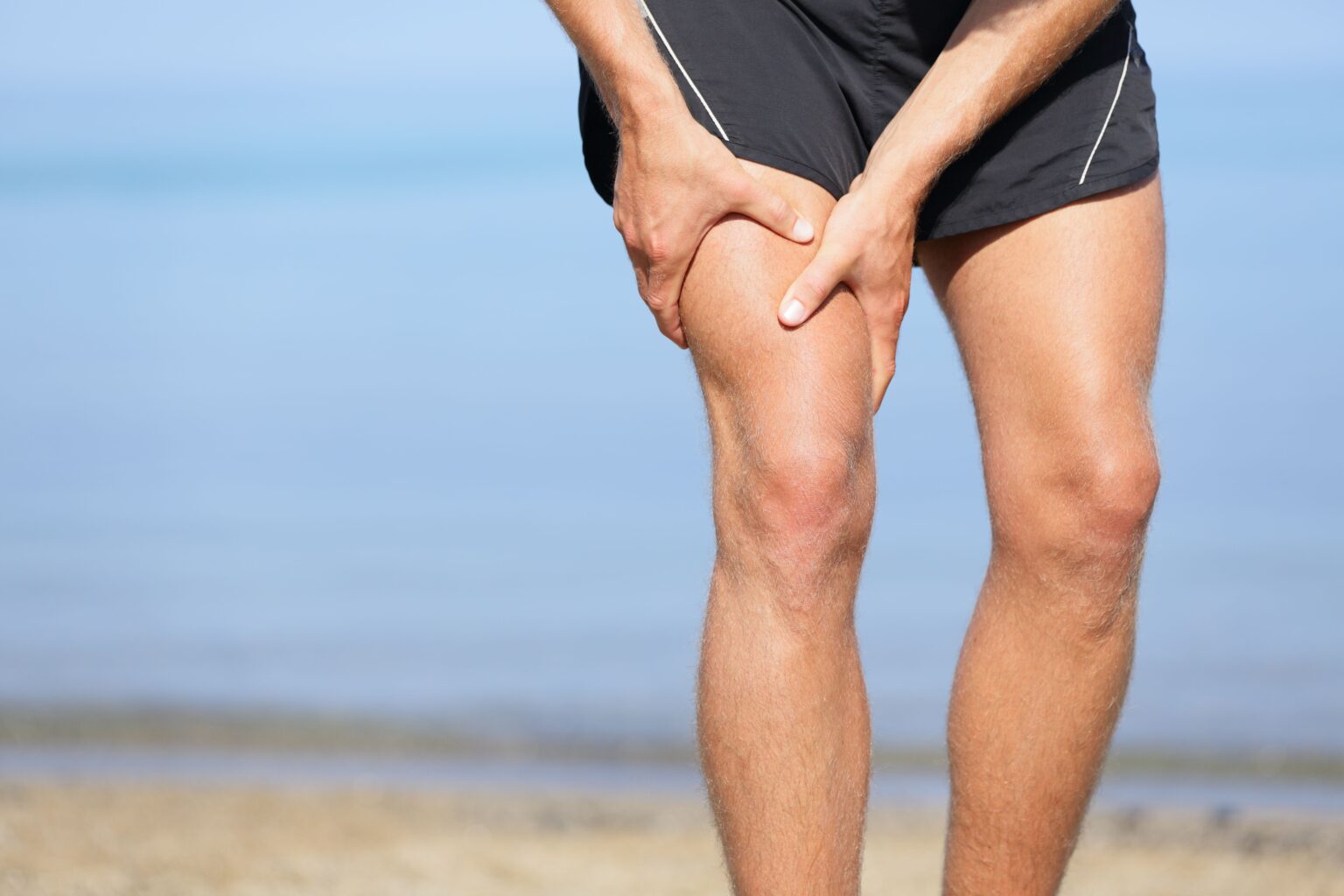Everyone deals with random aches and pains from time to time. But when it comes to a sharp pain in the front of your thigh, there are several possible causes.
The pain may be due to muscle injury, nerve issues, tendon damage, or sometimes an issue in another part of the body.
1. Muscle Soreness
One of the common reasons for sharp pain in the front of the thigh is delayed muscle soreness after exercise, says Joshua Scott, MD, a board-certified primary care sports medicine physician at Cedars-Sinai in Los Angeles. So if you are experiencing sharp pain in the front of your thigh and you have recently worked out or participated in physical activity, you may just need to rest your muscles. It may also be a good idea to speak with a trainer or physical therapist about how to support your muscles, such as with stretching or heat or ice therapy.
2. Quadriceps Tear
Outside of muscle soreness, Dr. Scott notes that thigh pain may also be attributed to more serious causes, such as a muscle strain or tear.
The quadriceps are a group of four large muscles in the front top of the thigh. The muscles extend from the thigh to the knee and are involved in walking, running, jumping, and many other leg movements. Falls, blows to the thigh, or vigorous training can cause the muscles — as well as the tendons that connect to the muscles and allow them to work — to tear partially or even rupture completely, according to the Cleveland Clinic.
Scott explains that the symptoms of a quadriceps tear include:
- Severe pain that starts suddenly, usually at the same time you are using the thigh muscles
- Pain while bearing weight on the affected leg
- Swelling and discoloration in the affected area
A complete tear can take months to heal, and it is important to return to activities slowly, under your doctor’s recommendations and guidance, as you recover. However, the American Academy of Orthopedic Surgeons notes that quadriceps tears are actually very rare and occur most often in middle-aged adults who are participating in sports that involve running or jumping.
3. Groin Pull
The groin muscles run from the hip to the inner thigh. Forceful movements of the inner thigh muscles can cause tears. Athletes who do hurdles, perform long jumps, and use repetitive starting and stopping motions are at greatest risk. But anyone can experience a groin pull, especially if you exert yourself more than usual, according to the Cleveland Clinic.
Scott notes that some symptoms of a possible groin pull include:
- A sudden onset of pain in the inner thigh, usually while exercising or with a quick movement
- Pain that gets worse when you make a movement that brings the legs together
- Pain and limping while walking
To recover from a groin pull, you should avoid strenuous activity that would aggravate the injury. You can also ice the area, take anti-inflammatory medication (such as ibuprofen), and wear a supportive bandage called a thigh wrap.
4. Hip Flexor Strain
The hip flexors are another group of muscles located in the upper part of the thigh that help to move the hip forward and up, notes the American Council on Exercise. As with other muscle groups, blows or forceful movements can cause a tear.
With a hip flexor tear, the pain is usually in the front of the hip or thigh and happens especially when lifting the leg, Scott says. He adds that this can occur with running or climbing stairs. Anyone who participates in activities with repetitive motions that involve the hip, such as running, hockey, soccer, football, or martial arts, are at the highest risk for this injury, according to the Cleveland Clinic.
Additionally, a hip flexor tear may be confused with a groin pull, since both conditions can cause pain in the groin area. As with a quadriceps tear, if the muscles suffer a complete tear, the pain will be more severe than a partial tear, and there will be a long recovery period. See your doctor if you suspect you have this type of injury.
5. Hip Arthritis
Pain in the front of your thigh may actually be referred pain (pain felt in a part of the body other than its actual source), Scott says. This can occur with arthritis of the hip. He explains that some characteristics of pain due to arthritis include:
- A slow onset of pain that can occur in the groin or radiate into the thigh or inner knee
- The pain occurs when you’re walking or turning the hip inward
- The pain may be mild and achy, or sharp
Hip arthritis can make weight-bearing activities difficult, and may be accompanied by stiffness, redness, and swelling. There are various forms of arthritis that can occur in the hip, so it is important to have the cause diagnosed so that the right treatment approach can be chosen.
6. Inguinal Hernia
A hernia occurs when there is a weakness somewhere in the abdominal wall, allowing the intestines to push through and causing the abdomen to bulge. If this happens in the lower portion of the abdomen, causing a downward bulge, it is called a groin or inguinal hernia, notes the Mayo Clinic.
According to Scott, symptoms of an inguinal hernia include:
- A sudden onset of pain in the groin that can travel to the thigh
- Pain that gets worse with coughing, sneezing, or with heavy lifting
- In some cases, a bulge in the groin may be felt when the pain occurs
See your doctor if you believe you have an inguinal hernia.
7. Nerve Pain
According to the American Academy of Orthopedic Surgeons, there is also a type of nerve damage called meralgia paresthetica that can cause pain in the outer thigh. This condition occurs when the nerve that runs along the side of the femur (your thigh bone) is compressed.
Symptoms of this condition can include:
- Pain on only one side of the outer thigh that may also extend to the outer side of the knee
- Burning sensation, tingling, or numbness
- Pain that radiates to the buttocks
The main causes of the nerve pain from this condition are due to restrictive clothing or excess weight putting pressure on the nerve. For example, individuals who wear tight stockings, girdles, or work equipment, such as a heavy tool belt, are at risk. Sometimes a seatbelt injury during a car crash can also cause the condition.
When to See a Doctor
Because there can be so many causes behind sharp pain in the front of the thigh, it may be difficult to know when you should seek medical attention.
Scott recommends seeing a doctor if the pain you are experiencing lasts for more than two weeks, the pain is severe, you are limping or can’t bear weight on your leg, there is swelling or redness, or if the pain is so severe that it wakes you up at night.
Read the full article here




